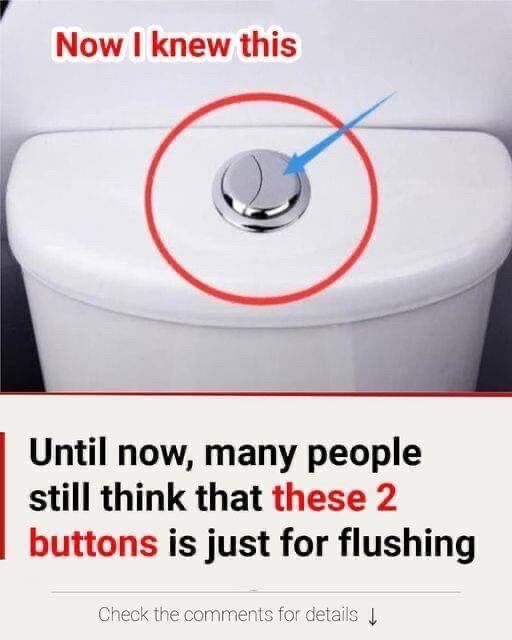Many people still believe that the two buttons on modern toilets are just there to flush, with no real difference between them. In reality, these dual flush buttons serve an important purpose that goes far beyond simply emptying the bowl—they’re designed to help save water and protect the environment.

Dual flush toilets are now common in many homes and public buildings, yet their functionality is often misunderstood or completely overlooked. Each button on a dual flush toilet has a specific role: the larger button is meant for flushing solid waste, typically using about 6 to 9 liters of water, while the smaller button is for liquid waste and uses only around 3 to 4.5 liters. By choosing the appropriate flush, you use only the amount of water necessary, which can make a huge difference over time. A household that uses these buttons correctly can save up to 20,000 liters of water per year compared to homes with traditional single-flush toilets.
That kind of conservation not only helps reduce your monthly utility bill but also plays a meaningful role in conserving a vital natural resource. Water conservation has become more important than ever as parts of the world struggle with droughts and water shortages. In this context, something as simple as choosing the right toilet flush button can contribute to global efforts to reduce water waste. The beauty of the dual flush system lies in its simplicity—you don’t need to make drastic changes to your lifestyle to be environmentally responsible. Just pressing the right button can have a ripple effect.
While dual flush toilets may cost slightly more to install than traditional models, the long-term benefits far outweigh the initial price tag. The reduced water usage translates into ongoing savings on your water bill, and in many places, governments and municipalities offer rebates or incentives for installing water-efficient appliances. So not only does it make environmental sense, but it makes financial sense too. The history of the dual flush concept is interesting and shows how forward-thinking the idea was from the very beginning. The concept was first introduced by Victor Papanek, an advocate for responsible and sustainable design, in 1976. While his idea was innovative, it didn’t come to life until 1980 when it was first implemented in Australia, a country known for facing frequent droughts and making significant efforts to manage its limited water resources.
Since then, the dual flush system has gained popularity around the world and is now a common fixture in bathrooms in both residential and commercial settings. Despite how widespread the technology has become, many people still don’t realize how to properly use it. They may press either button randomly, or default to the larger flush every time out of habit or misunderstanding. That’s why education is key. Understanding how and why the buttons work the way they do empowers users to make smarter choices every single day—choices that can have a positive impact on both the environment and their own finances. If you’re building a new home, renovating a bathroom, or simply replacing an old toilet, opting for a dual flush model is a smart move. And if you already have one, make sure you’re using it the right way. It only takes a moment to pause and consider which button is needed, and that brief moment of awareness can lead to significant benefits. These toilets were designed with intention, and using them properly means we’re honoring that design while doing our part for a more sustainable world. So the next time you see those two buttons, remember—they’re not just for flushing. They’re a simple but powerful tool for saving water, money, and the planet. With every flush, you have the opportunity to make a difference, and all it takes is pressing the right button.





